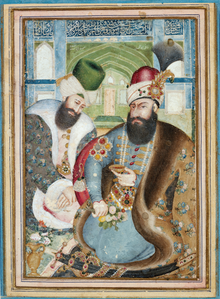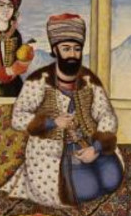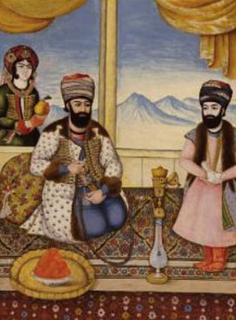| Ottoman–Persian War (1775–1776) | |||||||||
|---|---|---|---|---|---|---|---|---|---|
| Part of the Ottoman–Persian Wars | |||||||||
 Karim Khan Zand with the Ottoman envoy Vehbi Efendi. | |||||||||
| |||||||||
| Belligerents | |||||||||
| Commanders and leaders | |||||||||
| Strength | |||||||||
| Southern Persian Military, Zandieh Regiments | Unknown | ||||||||
| Casualties and losses | |||||||||
| Unknown | Unknown | ||||||||
The Ottoman–Persian War of 1775–1776 was fought between the Ottoman Empire and the Zand dynasty of Persia. The Persians, ruled by Karim Khan and led by his brother Sadeq Khan Zand, [4] invaded southern Iraq [5] and after besieging Basra for a year, took the city from the Ottomans in 1776. [6] The Ottomans, unable to send troops, were dependent on the Mamluk governors to defend that region.

The Ottoman Empire, historically known in Western Europe as the Turkish Empire or simply Turkey, was a state that controlled much of Southeast Europe, Western Asia and North Africa between the 14th and early 20th centuries. It was founded at the end of the 13th century in northwestern Anatolia in the town of Söğüt by the Oghuz Turkish tribal leader Osman I. After 1354, the Ottomans crossed into Europe, and with the conquest of the Balkans, the Ottoman beylik was transformed into a transcontinental empire. The Ottomans ended the Byzantine Empire with the 1453 conquest of Constantinople by Mehmed the Conqueror.

The Zand dynasty was an Iranian dynasty of Lak a branch of Lurs origin founded by Karim Khan Zand that initially ruled southern and central Iran in the 18th century. It later quickly came to expand to include much of the rest of contemporary Iran, as well as Azerbaijan, Bahrain, and parts of Iraq and Armenia.

Sadeq Khan Zand, also known as Mohammad Sadeq, was the fifth Shah of the Zand dynasty from August 22, 1779 until March 14, 1781.
Contents
In an attempt to raise troops and provisions for this war, Ottoman Sultan Abdülhamid I, made Suleiman al-Jalili mubayaaci (official of provisions), ordering him to send provisions to Baghdad, which he ignored, instead he restricted merchants from selling their goods. [7] As a result, the Persians held Basra until 1779 when the Ottomans, under Sulayman Agha, [8] retook the city, following Karim Khan's death. [9]

Baghdad is the capital of Iraq. The population of Baghdad, as of 2016, is approximately 8,765,000, making it the largest city in Iraq, the second largest city in the Arab world, and the second largest city in Western Asia.

Basra is an Iraqi city located on the Shatt al-Arab between Kuwait and Iran. It had an estimated population of 2.5 million in 2012. Basra is also Iraq's main port, although it does not have deep water access, which is handled at the port of Umm Qasr.








